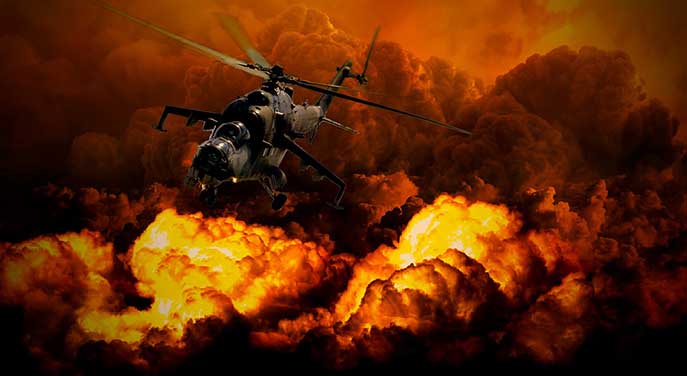Canada has been hiding under the United States defence umbrella for decades. That era is coming to an end
 There has been so much gravitas in my recent columns that it would be nice to lighten things up a bit. Unfortunately, the cheery news will have to wait while we probe the very real possibility of a third world war.
There has been so much gravitas in my recent columns that it would be nice to lighten things up a bit. Unfortunately, the cheery news will have to wait while we probe the very real possibility of a third world war.
While Canadians worry about increased capital gains taxes, the price of gas and governments that are more faithful to ideologies than they are to the people who elected them, the storm clouds are gathering for a much bigger concern. There is a growing threat that regional conflicts around the globe will coalesce into the unthinkable.
The notion of another global conflict seems as inconceivable as it is terrifying. Surely, we reason, our leaders would stop short of bringing on a conflagration so potent that it would put humanity’s very existence at risk.
That’s not necessarily so, in the view of some diplomatic and military authorities. And, for evidence, they point to events in the 20th century that preceded all-out war. One of those experts is Joseph P. Micallef, a historian, former war correspondent, and commentator on military and international affairs.
“If you are a student of history, you cannot miss the parallels of the 1930s with today,” he says. In the 1930s, there was a “rising crescendo of violence” that practically guaranteed a Europe-wide war would break out when Germany invaded Poland in 1939.
Today, conflicts in Ukraine and Gaza, confrontations between China and the Philippines, and Houthis active in the Red Sea are, in effect, proxy conflicts between the world’s major powers. And because of that, they have the potential to escalate into direct conflicts between those major powers.
“There are a number of major powers who are determined to change the international system into one that favours them,” Micallef says. While a global conflict is not imminent, the probability is now less than zero. This means Canadians need to start thinking about what they would do if the cards fall the wrong way.
World War III in the popular media is almost always portrayed as an Apocalyptic destruction of our social and physical infrastructure with massive loss of life. This is the so-called “mutually assured destruction” scenario in which two battling nations unleash every nuclear weapon in their arsenal. Micallef says that is not necessarily how the next global war will be fought.
The next war will be vastly different than the first two. In the previous conflicts, Canadians and Americans saw very few and very limited assaults on their continental territories. Today’s GPS-guided drones and ballistic missiles, however, are immensely more accurate than the bombs dropped during the Second War War.
“Ninety-five percent of the bombs used are going to work,” says Micallef. “The weapons are going to be far more lethal.” Which means, barring complex defensive measures, no corner of North America could be considered a safe refuge.
“If it actually becomes a shooting war, people (everywhere) will be in harm’s way.”
Yet it won’t necessarily be a shooting war because other techniques could help hostile nations achieve their objectives. Cyber attacks, for example, could easily shut down hospitals and power networks. If the goal is to weaken a nation by destroying its economy, then no weapons need to be fired at all.
Micallef urges Canadians to consider that widespread conflict, whether it is called a “world war” or just regional conflicts, is likely to happen within a generation. There are steps individuals and nations can take to prepare. For example, people might consider stocking up on potassium iodide (which eases the effects of radiation poisoning) while it’s cheap.
Canada, as a nation, needs to start rearming now – not to two percent of GDP, as the federal government keeps promising (yet not delivering), but perhaps a tripling of its current military spending. At the end of the Second World War, Canada had the fourth-largest navy in the world. Today, it is number 63, behind Iraq, Israel, and Peru. Somehow, we expect this tiny fleet to protect the world’s longest coastline, at 202,000 kilometres. Meanwhile, the Arctic is warming, making it possible that, within a generation, Canada’s Arctic will be a “blue-water theatre” of conflict between nations jostling for control.
Canada has been riding on the coattails of the United States for defence for decades but now needs to build up the capacity to defend itself.
“Canada has been spending the peace dividend for 80 years,” says Micallef. “That peace dividend is no longer there.”
It took generations to slowly, steadily erode Canada’s military capacity. It will take at least a generation to restore it, and that’s assuming successive governments maintain the resolve to stay the course and reallocate funds that are currently spent on other priorities.
You may wonder, is all this really necessary? Micallef urges us to think of it the same way we think about house insurance. “You don’t get fire insurance because you think your house will burn down,” he says. “You get it because the consequences of a fire, no matter how remote, are so devastating.”
Knowing the risks of global conflict doesn’t mean you have to turn into a prepper. But Canadians are unwise to leave their heads buried in the sand. You do have to consider that the once-unthinkable is indeed now possible. Maybe we should start girding for that possibility.
Doug Firby is an award-winning editorial writer with over four decades of experience working for newspapers, magazines and online publications in Ontario and western Canada. Previously, he served as Editorial Page Editor at the Calgary Herald.
For interview requests, click here.
The opinions expressed by our columnists and contributors are theirs alone and do not inherently or expressly reflect the views of our publication.
© Troy Media
Troy Media is an editorial content provider to media outlets and its own hosted community news outlets across Canada.


